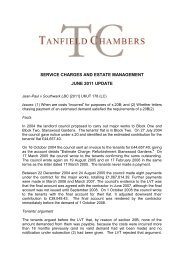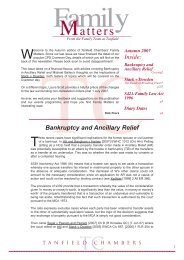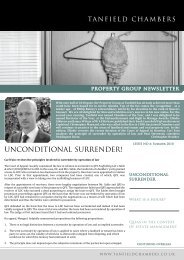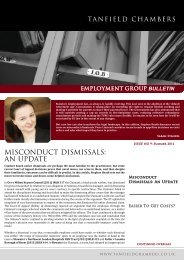Re Clarise Properties Ltd [2012] UKUT 4 (LC) - Tanfield Chambers
Re Clarise Properties Ltd [2012] UKUT 4 (LC) - Tanfield Chambers
Re Clarise Properties Ltd [2012] UKUT 4 (LC) - Tanfield Chambers
You also want an ePaper? Increase the reach of your titles
YUMPU automatically turns print PDFs into web optimized ePapers that Google loves.
<strong>Re</strong> <strong>Clarise</strong> <strong>Properties</strong> <strong>Ltd</strong> [<strong>2012</strong>] <strong>UKUT</strong> 4 (<strong>LC</strong>)<br />
LRA 1967 - Valuation – Haresign addition – amendment under the slip rule<br />
This case raises two issues: one of general importance relating to valuation and the other<br />
relating to procedure. The first is whether, in assessing the price payable for a leasehold house<br />
on enfranchisement , the valuation should be carried out in two stages or in three stages the<br />
last stage being what is known as a Haresign addition. The Lands Chamber indicated that in<br />
future all valuations should be carried out in three stages.<br />
The procedural point was whether the LVT had exceeded its powers to correct a decision under<br />
the slip rule.<br />
Valuation of a leasehold house under s. 9 (1) LRA 1967<br />
The valuers reading this will appreciate that a s. 9 (1) valuation involves (i) capitalizing the value<br />
of the rent payable for the period of the unexpired term of the existing tenancy and (ii)<br />
capitalizing the value of the section 15 rent. The point at issue in this case was whether one<br />
should then go on and value separately the value of the landlord’s ultimate reversion as a<br />
separate calculation (the Haresign addition).<br />
From the earliest days of valuations under section 9(1) it was common practice to adopt a twostage<br />
approach to valuation, not quantifying separately the value of the reversion at the end of<br />
the assumed 50-year lease renewal but rather capitalizing the section 15 rent in perpetuity. The<br />
justification for not valuing the ultimate reversion separately was that, given the period of<br />
deferment and the small amounts of value involved, any difference in the end result would be<br />
minimal and would be lost in the other elements of the valuation.<br />
In Haresign v St John’s College, Oxford (1980) 255 EG 711 the landlord’s valuer (Mr Barnes) said<br />
that in most cases any addition through attributing a specific value to the reversion would be<br />
“microscopically small”. In that case, however, he had adopted a three-stage approach because<br />
it resulted in a gain of £349 to the landlord (in a total valuation of about £6,000), which, he said,<br />
was material (see at 546). The Tribunal (V G Wellings QC) adopted his approach.
Thereafter the extra value resulting from a three-stage approach became known as a<br />
“Haresign addition”. The two-stage approach continued as standard practice, and<br />
a Haresign addition was only made as an exception to it. Several cases at LT level had approved<br />
a three stage valuation where it could be shown that it made a material difference to the<br />
valuation<br />
In this case the Tribunal (George Bartlett QC, President and N J Rose FRICS) stated that the time<br />
has come for a change in valuation practice:<br />
“We consider that the time has now come to move away from the two-stage approach<br />
as the standard practice in section 9(1) valuations and to apply instead the three-stage<br />
approach. As a matter of good valuation practice, where a price has to be determined,<br />
every element of value should in general be separately assessed unless there is some<br />
good reason not to do so. There is now a much greater likelihood that the ultimate<br />
reversion will have a significant value than there was when the two-stage approach<br />
became adopted as standard practice 40 years or more ago. There are two reasons for<br />
this. The first is that house prices, including the prices of houses that would fall to be<br />
valued under section 9(1), have increased substantially in real terms; and the second is<br />
the lower deferment rates that are now applied in the light of Sportelli. There is, we<br />
think, a real danger that applying the two-stage approach as standard will in some cases<br />
lead to the exclusion of an element of value that ought to be included in the price. This<br />
is particularly so if valuers and LVTs treat as the criterion for the application of<br />
a Haresign addition whether the house is “substantial” and thus exclude any element of<br />
value in the ultimate reversion (other than that included in the capitalisation of the<br />
section 15 rent in perpetuity) where the house does not meet this ill-defined criterion.<br />
The only relevant question is whether the reversion does have a significant value. In<br />
future, therefore, we consider that the appropriate approach will be to capitalise the<br />
section 15 rent to the end of the 50-year extension and to assess the value (if any) of the<br />
ultimate reversion.”<br />
The procedural point – application of the slip rule<br />
The LVT’s power to alter a decision is conferred by regulation 18(7) of the 2003 <strong>Re</strong>gulations.<br />
The Tribunal held that it is very restricted in scope being in essence a slip rule. The limitations of<br />
such a rule were stated in Bristol-Myers Squibb Co v Baker Norton Pharmaceuticals Inc [2001]
EWCA Civ 414 by Aldous LJ, with whom Laws LJ and Blackburne J agreed, where at paragraph 25<br />
he concluded that the authorities established that<br />
“the slip rule cannot enable a Court to have second or additional thoughts. Once the order<br />
is drawn up any mistake must be corrected by an appellate Court. However it is possible<br />
under the slip rule to amend an order to give effect to the intention of the Court.”<br />
On the facts of the case the LVT had clearly had second thoughts and attempted to incorporate<br />
these through the issue of a certificate of correction issued under regulation 18. The Tribunal<br />
held that the LVT has exceeded its authority in so doing.<br />
The Tribunal, however, also helpfully added that<br />
“in about a year’s time, [when the] LVTs’ powers are transferred to the First-tier<br />
Tribunal, it is likely that there will be a wider power to review a decision, as there is in<br />
rule 44 of the present Tribunal Procedure (First-tier Tribunal) (General <strong>Re</strong>gulatory<br />
Chamber) Rules 2009; and express provision will be made for giving every party an<br />
opportunity to make representations before a decision is altered on review (see rule<br />
44(3)).


![Re Clarise Properties Ltd [2012] UKUT 4 (LC) - Tanfield Chambers](https://img.yumpu.com/36301708/1/500x640/re-clarise-properties-ltd-2012-ukut-4-lc-tanfield-chambers.jpg)










